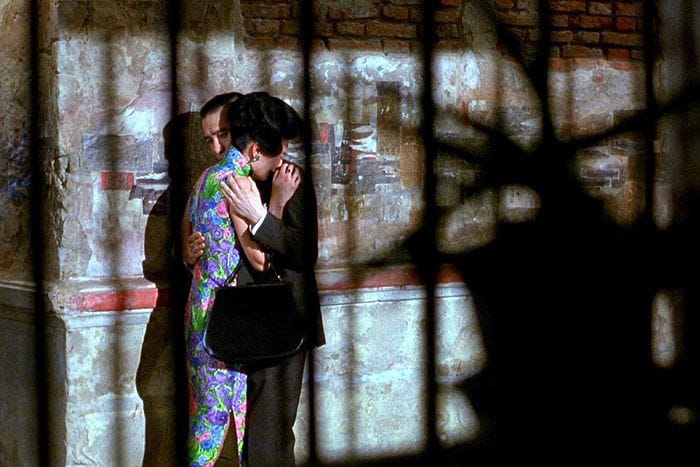In The Mood for Love

I just finished watching the 2000 Wong Kar-Wai masterpiece “In the Mood for Love” this evening. And while I don’t see the need to write a full review of the film — I’ve seen it several times and have written about it before — I may want to revisit the film scene by scene in the future. There’s a great deal of subtlety in the film, so a focused, observational approach could pull out a great deal.
I just want to focus on one aspect of the film tonight — and that’s how the eroticism of the movie has nothing to do with sex. The film is basically about how two married people enter into an affair and how the scorned half of each couple come together to pick up the pieces of this joint catastrophe.
The cheating half of the couples is never seen. We just get the sordid details about them — the lying, the fake business trips, the clumsy gift giving that gives away what they’ve been up to.
The jilted half of the couples tells us the story. In the most fascinating section of the film, they meet occasionally to try to recreate how the affair happened and what their partners need to do to keep covering it up. They turn the affair into an interpersonal workshop where they perform scenes and test out dialogue.
This draws the jilted couple together, but interestingly, not towards an equal and opposite sexual relationship. First, they form a creative partnership where they collaborate on kung fu stories (likely in the form of anime.) This leads them to have to get together, which makes them have to take discreet precautions as if they were having a sexual affair.
So the movie pulls off this very clever trick of making their perfectly above board meeting of minds something to be noticed and commented upon.
In the film’s final 20 minutes (shockingly late if you think about it) the movie does signal that their affair was consummated at least once and, perhaps, revived again briefly in Singapore a few years later.
The movie also hints that this led to them having a love child — and to the movie’s heartbreaking conclusion, where Tony Leung’s character Chow Mo Wan whispers the secret of their love affair into the temple of Angkor Wat and covers up the hole with mud to preserve it.
This is a movie where longing and sadness are by far the most erotic feelings. Any sex that happened seems incidental, necessary to complete the story, but not something that changed their relationship in any significant way.
I don’t believe there’s ever been a movie quite like “In the Mood for Love,” a moody, puzzling work of art where everything significant is communicated indirectly, cautiously, even reluctantly. It’s a movie where rainstorms and slow motion walks up stairways form the visual poetry that make it all seem like a deep mediation on love, even though it flies by in barely more than 90 minutes.